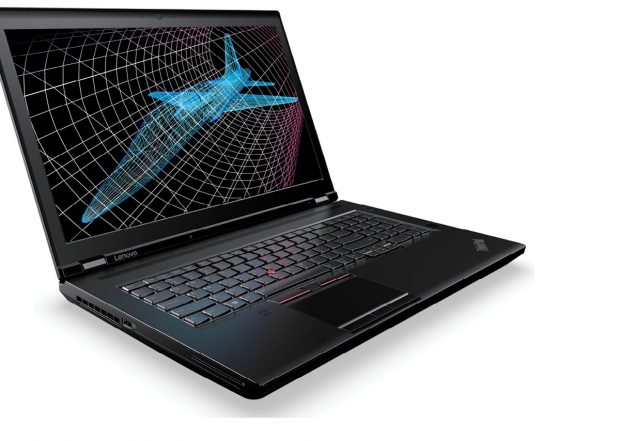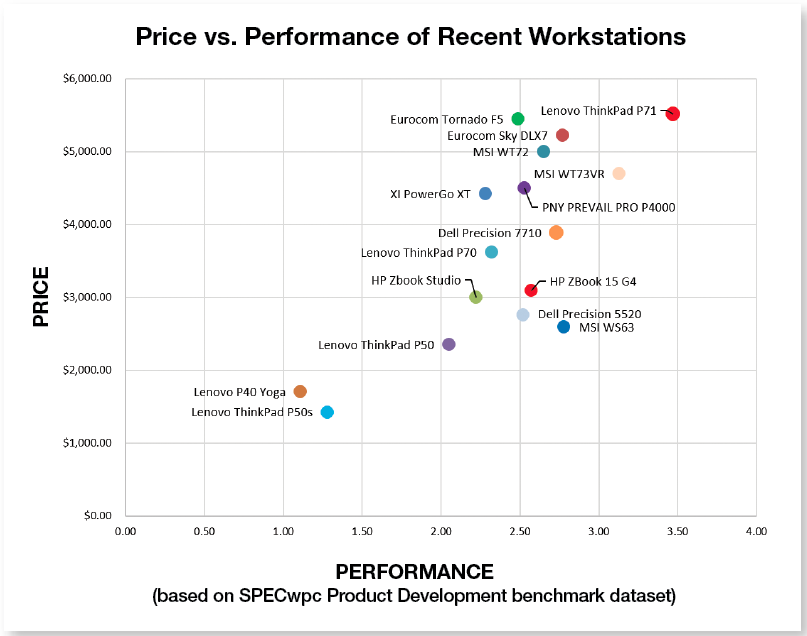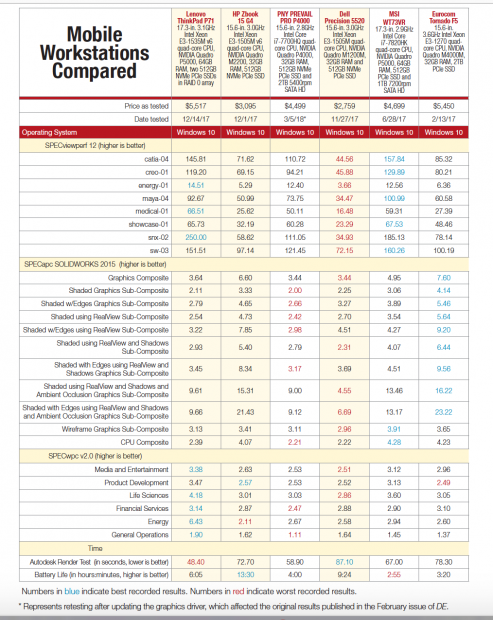Lenovo ThinkPad P71: A New Performance Leader

The Lenovo ThinkPad P71 comes in a dark gray sculpted case. The familiar Lenovo red pointing stick has its own set of buttons above the trackpad. Image courtesy of Lenovo.
Latest News
May 1, 2018
Lenovo recently sent us its new ThinkPad P71 mobile workstation, the latest update to the P series (we previously reviewed the P70, DE July 2016), and the only VR-certified ThinkPad (when equipped with either an NVIDIA Quadro P4000 or P5000 graphics card). The P71 now marks the top of the ThinkPad line and is aimed at designers and engineers who run the most demanding applications and want a large screen and a high level of storage.
Like its predecessor, the Lenovo ThinkPad P71 comes housed in a charcoal gray case made from magnesium and aluminum and wrapped in glass fiber and polyphenylene sulfide. The system measures 16.4x10.8x1.2-in. and weighs 8.19 pounds. The large 230-watt external power supply (7.9x3.9x1.0-in.) adds another 2.17 pounds, including its cables.
Raising the lid reveals a 17.3-in. display and a 105-key backlit keyboard with separate numeric keypad. The excellent, spill-resistant Lenovo keyboard is perhaps the best available in a current laptop. Lenovo offers a choice of two ISP matte surface displays: FHD (1920x1080) or 4K (3840x2160). Unlike the P70, however, there is no touch option. The 4K panel provided in our evaluation unit added $260 to the price. A 720p webcam flanked by a pair of microphones is centered above the display.
A round power button is located adjacent to the upper-right corner of the numeric keypad while a fingerprint reader is positioned to its lower-right corner. A newly designed 4x2.25-in. touchpad with three dedicated buttons is centered below the spacebar. There is also a red pointing stick nestled between the G, H and B keys with its own three buttons directly below the spacebar. A pair of stereo speakers is concealed beneath perforations just above the keyboard. The caps lock and number lock keys each have their own LED as do separate keys dedicated to the speakers and microphone. There is also a hard drive activity light located below the display.
 The Lenovo ThinkPad P71 comes in a dark gray sculpted case. The familiar Lenovo red pointing stick has its own set of buttons above the trackpad. Image courtesy of Lenovo.
The Lenovo ThinkPad P71 comes in a dark gray sculpted case. The familiar Lenovo red pointing stick has its own set of buttons above the trackpad. Image courtesy of Lenovo.Recognizing that color temperatures and screen brightness can drift over time, Lenovo also included a color sensor (a $70 option on the base model), located to the left of the touchpad. A color calibration tool appears in the Windows taskbar and turns red if you haven’t calibrated the display in more than 30 days. A single click starts the X-Rite Pantone calibration software, which uses the sensor to ensure that the display quality remains consistent and accurate over the life of the computer. After choosing the desired settings, you simply follow the instructions to close the lid and allow the tool to calibrate the display, which takes just more than a minute.
Choice of Quality Components
The Lenovo ThinkPad P71 is built around one of the latest seventh-generation Intel Core or Xeon “Kaby Lake” processors. The base configuration, which has a starting price of $1,511, comes with a 2.8GHz Intel Core i7-7700HQ CPU. Other choices include the 2.9GHz Core i7-7820HQ, the 3.0GHz Xeon E3-1505M and the 3.1GHz Xeon E3-1535M v6 processor that came in our evaluation unit, adding $690 to the price. That CPU has an 8MB SmartCache, a 45-watt thermal design power (TDP) rating, and a maximum turbo frequency of 4.2GHz.

Although these CPUs all incorporate Intel HD Graphics P630, every ThinkPad P71 model also includes discrete graphics in the form of an NVIDIA Quadro GPU. The base P71 configuration uses a Quadro M620 with 2GB of memory. Other choices include the Quadro P3000 (adding $300) and P4000 ($800 more). Our system came with an NVIDIA Quadro P5000, which added $1,400 to the total cost. That GPU includes 16GB of GDDR5 memory. This 180-watt GPU provides 2,048 CUDA cores, uses a 256-bit interface and delivers a bandwidth up to 288GB per second.
Lenovo offers many memory options. The base P71 configuration comes with 8GB of DDR4 memory. Other choices include up to 64GB, and ECC memory is an option when paired with an Intel Xeon processor. Our system came with 64GB of ECC RAM (adding $940 to the cost), installed as four 16GB 2400MHz SODIMM modules.
Although the entry-level system comes with a 500GB 7200rpm hard drive, our evaluation unit came with a pair of 512GB SSD PCIe-NVMe drives, configured in a RAID 0 array for a total storage capacity of 1TB, a configuration that added another $1,081. Although this yields the best performance, RAID 0 splits data evenly across the two drives, without redundancy or fault tolerance, so a failure of one drive will cause the entire array to fail.
As we have come to expect, the P71 includes lots of connectivity options. The right side provides a combination microphone/headphone audio jack, three USB 3.0 ports, a media-card slot, an ExpressCard slot, a mini DisplayPort connector and a security-lock slot. The left side houses an always-on USB 3.0 port that can charge USB devices whenever the computer is connected to AC power, even if the system is off. There is also a smart card slot and a drive bay that can accommodate an optical drive (as on our evaluation unit) or an additional hard drive on some models. The rear panel provides two Thunderbolt 3/USB Type-C connectors as well as an HDMI port, an RJ45 Ethernet jack and the connector for the external power supply. The bottom of the case features a docking station connector and an easily removable battery. Inside the battery compartment there is also a micro-SIM card slot. There is also a pair of holes designed to drain liquids in the event of a spill on the keyboard.
Dual-band Wi-Fi and Bluetooth come standard. Although an eight-cell 96Whr Lithium-ion battery is the only choice, it kept our ThinkPad P71 running for just over 6 hours, more than 45 minutes longer than the P70. The Lenovo mobile workstation remained cool and nearly silent throughout our tests (reaching 46dB under heavy compute loads).
Even Better Performance
Lenovo workstations typically deliver top-of-class performance, but the Lenovo ThinkPad P71 exceeded our expectations. On the SPECviewperf benchmark, which focuses on graphics, the P71 scored at or near the top on nearly all the datasets. The P71 also did quite well on the SPECapc SOLIDWORKS benchmark, although it lagged behind other 17.3-in. mobile workstations we’ve tested recently.
On the very demanding SPECwpc benchmark, however, the Lenovo ThinkPad P71 delivered the top scores in all six categories and even outperformed many desktop systems on some of the individual tests. And on the AutoCAD rendering test, the P71 averaged a record-setting 48.4 seconds to complete each image, beating the ThinkPad P70.
Although the base configuration comes with Windows 10 Home, Windows 10 Professional 64-bit (which costs $30 more) is preloaded on systems equipped with an Intel Xeon CPU. The standard warranty covers the system for just one year with depot or carry-in service. Additional coverage is available at the time of purchase that can extend the warranty for up to five years, including accidental damage protection. Our system came with a three-year warranty. Lenovo also offers a ThinkPad workstation dock (on sale for $210 at press time) that works with the P51 and P71 workstations and provides lots of additional ports—a great option for anyone who travels often but works at a desk when in their office.
The ThinkPad P71 is certified for more than 100 applications from ISVs including Autodesk, Dassault Systèmes, PTC and Siemens. You can build a custom configuration via the Lenovo website (where our P71 priced out at $5,517 after an automatic 10% online discount). Although that price places the Lenovo ThinkPad P71 at the high end in terms of cost, its performance exceeds that of any mobile workstation we have ever tested, making it the new price/performance leader.
For More Info
Lenovo ThinkPad P71
- Price: $5,517 as tested ($1,511 base price)
- Size: 16.4x10.8x1.2-in. (WxHxD) notebook
- Weight: 8.19 pounds (plus 2.17-pound external power supply)
- CPU: Intel Xeon E3-1535M v6 3.10GHz quad-core w/ 8MB cache
- Memory: 64GB ECC DDR4 at 2400MHz
- Graphics: NVIDIA Quadro P5000 w/16GB GDDR5 memory
- LCD: 17.3-in. 4K (3840x2160) IPS with color calibration sensor
- Hard Disk: two 512GB PCIe 3 NVMe M.2 SSDs in RAID 0 array for 1TB storage
- Floppy: none
- Optical: DVD burner
- Audio: built-in speakers, headphone/microphone jack, built-in microphone array
- Network: integrated Intel Dual Band Wireless AC (2x2) 8265 plus Bluetooth 4.1, one RJ45 gigabit Ethernet port
- Modem: none
- Other: four USB 3.0 (one always on), mini DisplayPort, HDMI, SmartCard reader, media card slot, express card slot, 720p webcam, two Thunderbolt 3/USB Type-C connectors
- Keyboard: integrated 105-key full-size backlit keyboard with numeric keypad
- integrated touchpad with three buttons,
Pointing stick with three buttons, fingerprint reader
Subscribe to our FREE magazine, FREE email newsletters or both!
Latest News
About the Author
David Cohn is a consultant and technical writer based in Bellingham, WA, and has been benchmarking PCs since 1984. He is a Contributing Editor to Digital Engineering, the former senior content manager at 4D Technologies, and the author of more than a dozen books. Email at [email protected] or visit his website at www.dscohn.com.
Follow DE





